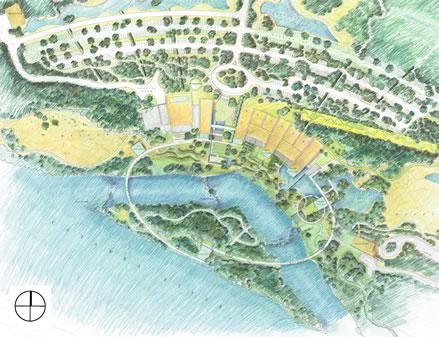
by Larry High
AIA North Carolina
"Architects are no longer able to say destruction of the environment is not a part of our plans. Rather, history reveals it is our de facto plan," according to the founding principal of William McDonough + Partners, Architecture and Community Design, Charlottesville, Va., an internationally recognized design firm practicing ecologically, socially, and economically intelligent architecture and planning in the U.S. and abroad.
William McDonough, FAIA, former dean of the School of Architecture at the University of Virginia, called for a major cultural change in the way our environment is treated during an hour-long seminar for participants at the annual AIA convention in Charlotte, May 10.
During the two-part session shared with Christopher Hayes of his firm, McDonough said architects must "treat nature as our model and our mentor." The question facing today's designers is not one of no growth, he said, but rather, "What do we want to grow?"

McDonough predicts "The Next Industrial Revolution" as the answer to the question, "What about human health and ecological health?"
The theme of the first Industrial Revolution, according to McDonough, was "If brute force doesn't work, you're not using enough of it." But societies have no Bill of Rights allowing them to give people cancer, respiratory ailments or a host of other physical and mental afflictions, he exhorted.
Born in 1951 in Tokyo and raised in Hong Kong, McDonough said it was there he learned respect for the environment. "Relationship to the environment matters there because every square inch of land matters," he explained.
Referring to the Hannover Principles he developed, McDonough told the standing-room-only audience that architects should expand their design considerations to respect even distant effects. "We must accept responsibilities for our actions, eliminate the concept of waste, and learn to rely on natural energy.
"When do we have buildings that will make more energy than they consume? When do humans become tools of nature?" he asked.
Hayes, who focused on his firm's design for The Museum of Life and the Environment, in York County, S.C., led the last half of the seminar. He called the "green museum" an attempt to develop a "place where you can hardly separate where buildings end and landscape begins.
"This is not a black box separated from its environment," he said of the museum on the bank of the Catawba River, 30 minutes south of Charlotte. The previously undeveloped 400-acre site will reconnect the local community to the river, its developers say.
As McDonough + Partners' first museum project, the architecture and its systems seek to demonstrate natural processes in a living architecture.
Among the building systems are heating and cooling designs, which will involve a radiant floor system that works with the mass of the earth and the coolness of the water to regulate temperature. Photovoltaics will utilize the sun's energy to power the building while the primary structural walls, built of custom, hollow-concrete blocks measuring three by five feet, will pass air through the facility.
"All of our projects celebrate nature and encourage connection to the world outside," McDonough concluded.
Copyright 2002 The American Institute of Architects. All rights reserved.
![]()
|
|
|